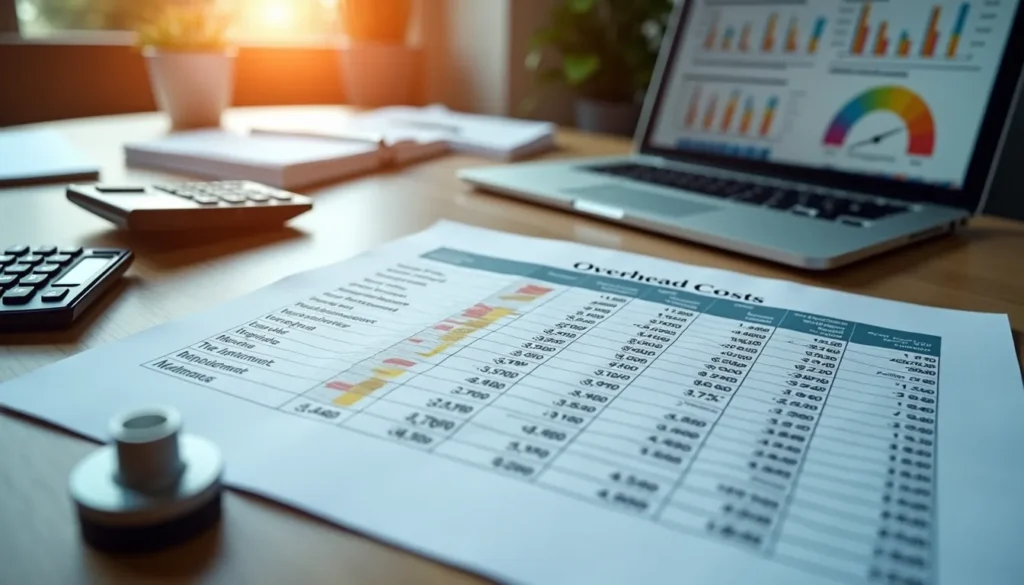Monitoring Overhead Expenses For Successful Business This 2024

Understanding how monitoring overhead expenses is key to running a successful business. Overhead expenses are costs that do not directly tie to producing your product or service. They are the bills that keep your business running, like rent, utilities, and salaries. Knowing how to track these costs can help you keep your business healthy and profitable.
Key Takeaways
- Overhead expenses are costs that keep your business running but do not directly link to production.
- Monitoring these costs helps you understand where your money goes.
- You can use software tools to help track these expenses with ease.
- Regular reviews of your costs can find areas to save money and increase profits.
- Clear reports on your expenses guide pricing and business decisons.
- Understanding cost control strategies can further enhance your financial management.

What Are Overhead Expenses?
Overhead expenses are the costs needed to run your business but not tied to making a specific product. Think of things like rent for your office, electricity to keep the lights on, and salaries for your staff. These costs can be fixed or variable.
- Fixed Overhead: These costs stay the same each month. For example, your rent does not change.
- Variable Overhead: These can change. For instance, your utility bill may vary each month.
Tracking these expenses is important. If you don’t keep an eye on them, they can sneak up on you.
Overview of Overhead Costs
| Type of Overhead Expense | Description | Example |
|---|---|---|
| Fixed Overhead | Costs that remain constant | Rent |
| Variable Overhead | Costs that fluctuate | Utility bills |
| Semi-variable Overhead | Costs that have a fixed and a variable component | Salaries with bonuses |
Different Types of Overhead Expenses
Understanding the different types of overhead expenses helps you know where your money goes. Here are a few:
Administrative Costs
These are costs related to managing your business. Salaries for office staff and expenses for office supplies fall into this group.
Rent and Utilities
This includes the money you pay for your office or store space and the bills for things like electricity or water.
Employee Benefits
Things like healthcare and retirement plans for your employees also count as overhead costs.
Marketing Costs
Money spent on advertising and promotions is part of your overhead. This helps you attract customers and grow your business.

Why Monitor Overhead Expenses?
Monitoring your overhead expenses helps you see how much you spend and where you can cut back. This can save money and help your business thrive. If you don’t monitor these costs, you may not know when you are spending too much. Here are some reasons to keep a close eye on your overhead:
- Improve Profits: When you know your costs, you can set prices that ensure you make a profit.
- Identify Waste: Monitoring helps you find areas where you spend too much. You can then cut back on those costs.
- Better Budgeting: Understanding your overhead helps you create a budget that fits your business needs.
- Informed Decisions: When you have clear data about your expenses, you can make smarter choices for your business.
How to Monitor Overhead Expenses
Monitoring overhead expenses may feel hard, but it doesn’t have to be. Here are steps to make it easier:
1. Choose the Right Software
Using software designed for tracking overhead costs can make this task easier. Look for programs that help you enter and categorize your expenses. MyOverhead is an option that many businesses find helpful.
2. Keep All Your Records
Collect and save all your bills and receipts in one place. This makes it easier to enter costs into your software. You can also use features that allow you to upload documents directly.
3. Categorize Your Costs
Break down your overhead costs into categories. This allows you to see where your money goes. You can spot trends or areas where costs are rising.
4. Review Regularly
Set a time each month to check your overhead expenses. Look for changes and patterns. This helps you stay informed about your business finances.
5. Adjust as Needed
If you notice certain expenses are too high, look for ways to reduce them. For example, if your utility bills are rising, see if there are ways to save energy.
Tips for Effective Tracking
- Use cloud-based software for easy access.
- Create color-coded categories for visual tracking.
- Set up reminders for when bills are due.
- Share reports with your team for transparency.

Using Reports to Your Advantage
Once you start monitoring your overhead expenses, you will want to make reports. These reports can guide your decision-making. Here’s how to use them:
Summary Reports
These reports show you an overview of your costs. They can help you understand how much you spend overall and by category. Use these reports to compare your current costs to previous months.
Overhead Reports
These reports dive deeper into specific costs. You can see what makes up your overhead and identify areas to cut back. This can be helpful when you need to adjust your budgets.
Break-Even Reports
Break-even reports show you how much money you need to bring in to cover your costs. This number is key to ensuring your business stays profitable.
Comparative Cost Analysis
| Month | Total Overhead Costs | Marketing Expenses | Utility Expenses |
|---|---|---|---|
| January | $5,000 | $1,200 | $300 |
| February | $4,800 | $1,000 | $250 |
| March | $5,200 | $1,500 | $400 |
The Benefits of Continuous Monitoring
Keeping an eye on your overhead expenses is not a one-time task. It’s an ongoing process. By continuously monitoring these costs, you can enjoy several benefits:
- Increased Awareness: You stay aware of how much you spend and where. This knowledge helps you adjust your spending habits.
- Better Financial Health: Knowing your costs can lead to better profits and financial stability. Healthy finances mean your business can grow.
- Smart Pricing Strategies: When you know your costs, you can set prices that ensure profits while remaining competitive.
Overcoming Common Challenges
Even with the right tools and methods, you may face challenges in monitoring overhead expenses. Here are a few and how to handle them:
1. Lack of Time
You are busy running a business, and there may not seem to be enough time to monitor expenses. However, setting aside regular times each month can help. The software can also automate some tasks, reducing the time you need.
2. Keeping Data Accurate
Errors in data entry can lead to incorrect reports. To avoid this, double-check your entries. Use the upload features of your software to reduce typing errors.
3. Understanding the Data
Sometimes, reports can feel overwhelming. If you are unsure how to read them, seek help. Many accounting professionals can guide you through your reports and help you understand the numbers.
4. Resistance to Change
If you have not monitored your costs before, it can be hard to start. Change takes time. Be patient with yourself as you learn this new process.

Real-Life Examples of Effective Monitoring
Many businesses have seen the benefits of monitoring overhead expenses. Here are some simple examples:
A Restaurant’s Journey
A small restaurant struggled with rising costs. The owner began using MyOverhead to track their expenses. They discovered that their food costs were too high. By reviewing their suppliers and changing some menus, they reduced costs significantly. This effort led to better profits.
A Contractor’s Success
A local contractor used to guess their overhead costs. After starting to monitor these costs with software, they found savings in their labor costs. They adjusted their pricing to reflect their true costs and saw profits increase in just a few months.
Conclusion
Monitoring overhead expenses is vital for any business. It helps you understand where your money goes and find ways to save. Using software makes this process much simpler. Regularly reviewing your costs allows you to adjust and keep your business healthy.
By learning how to track and manage these expenses, you set your business up for success. Every dollar counts, and knowing your overhead will help you make the right choices. Start today, and watch how it improves your bottom line.
Start Monitoring Today
Don’t wait to take control of your overhead costs. Use the steps and tips outlined here to start monitoring your expenses. With a little time and effort, you can ensure your business runs smoothly and profitably. Remember, the earlier you start, the better your financial outlook will be. You’ve got this!
For more insights on maintaining healthy financial practices, check out our guide on effective cost management techniques.

Leave a Reply